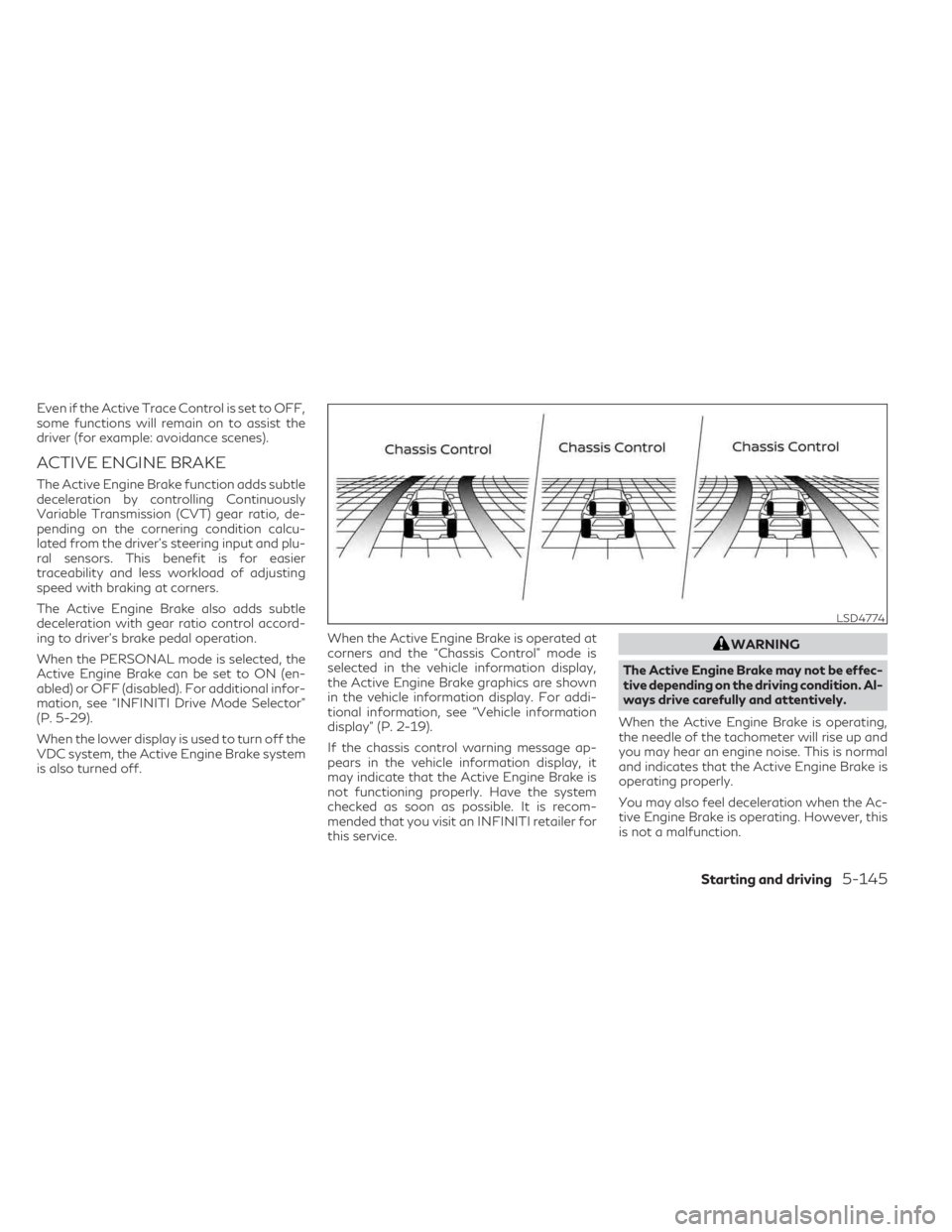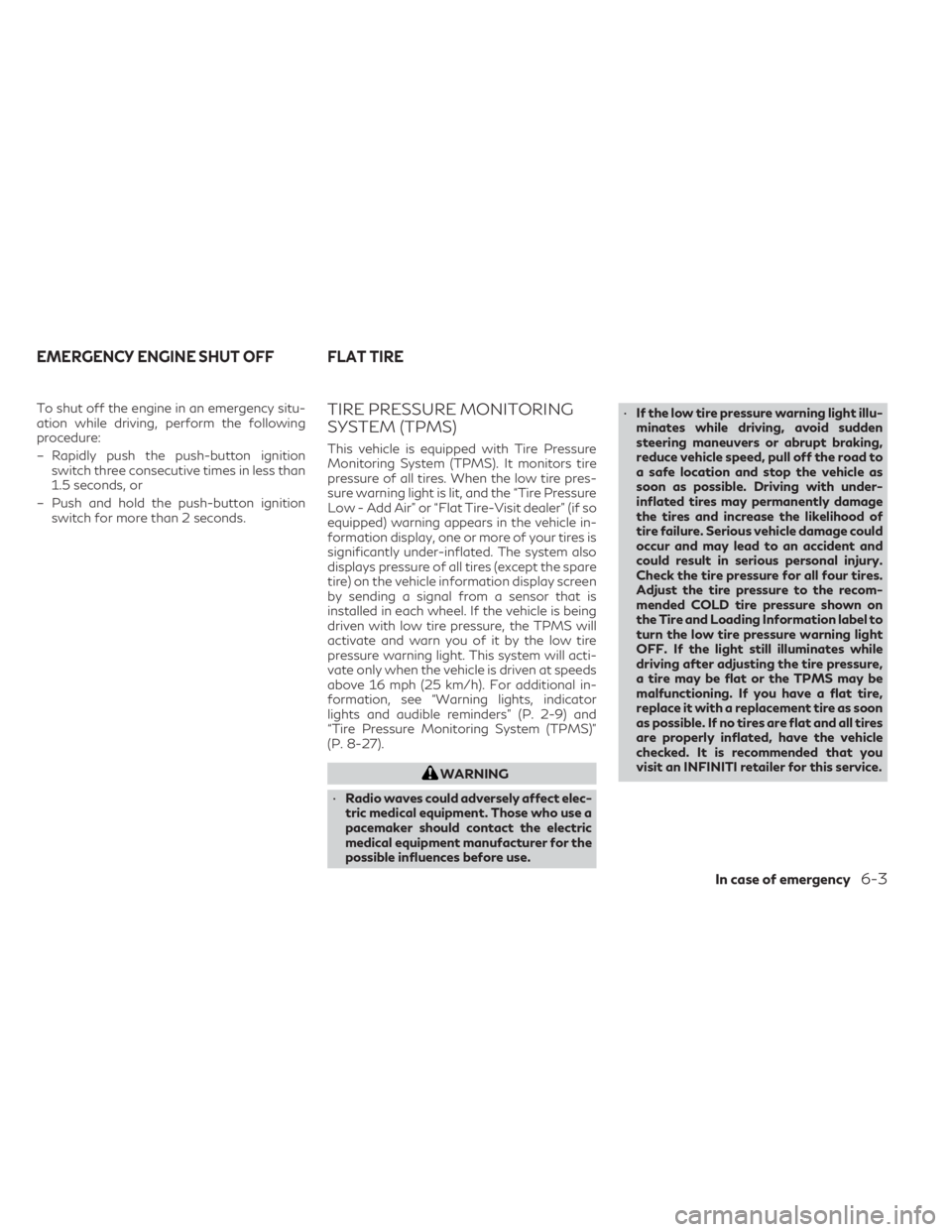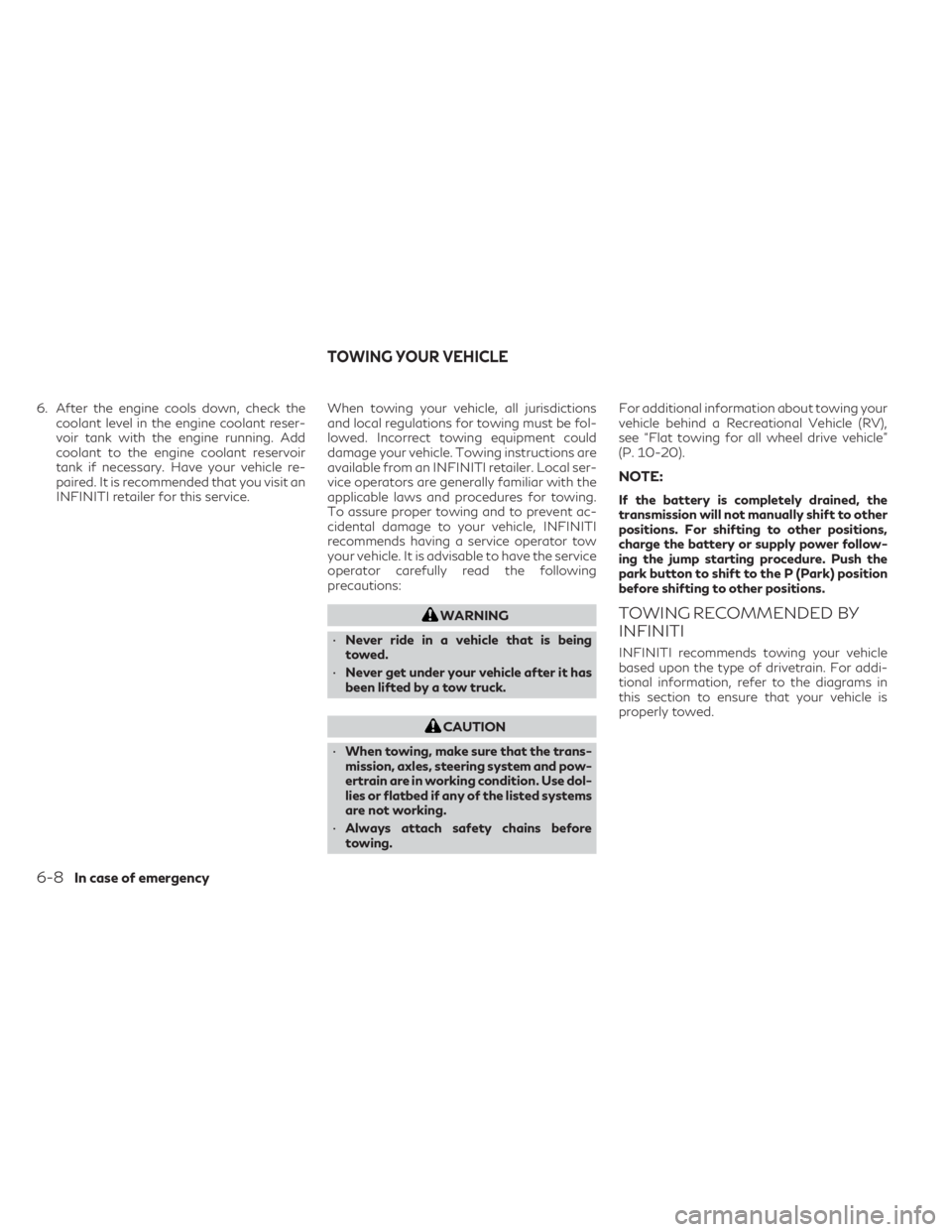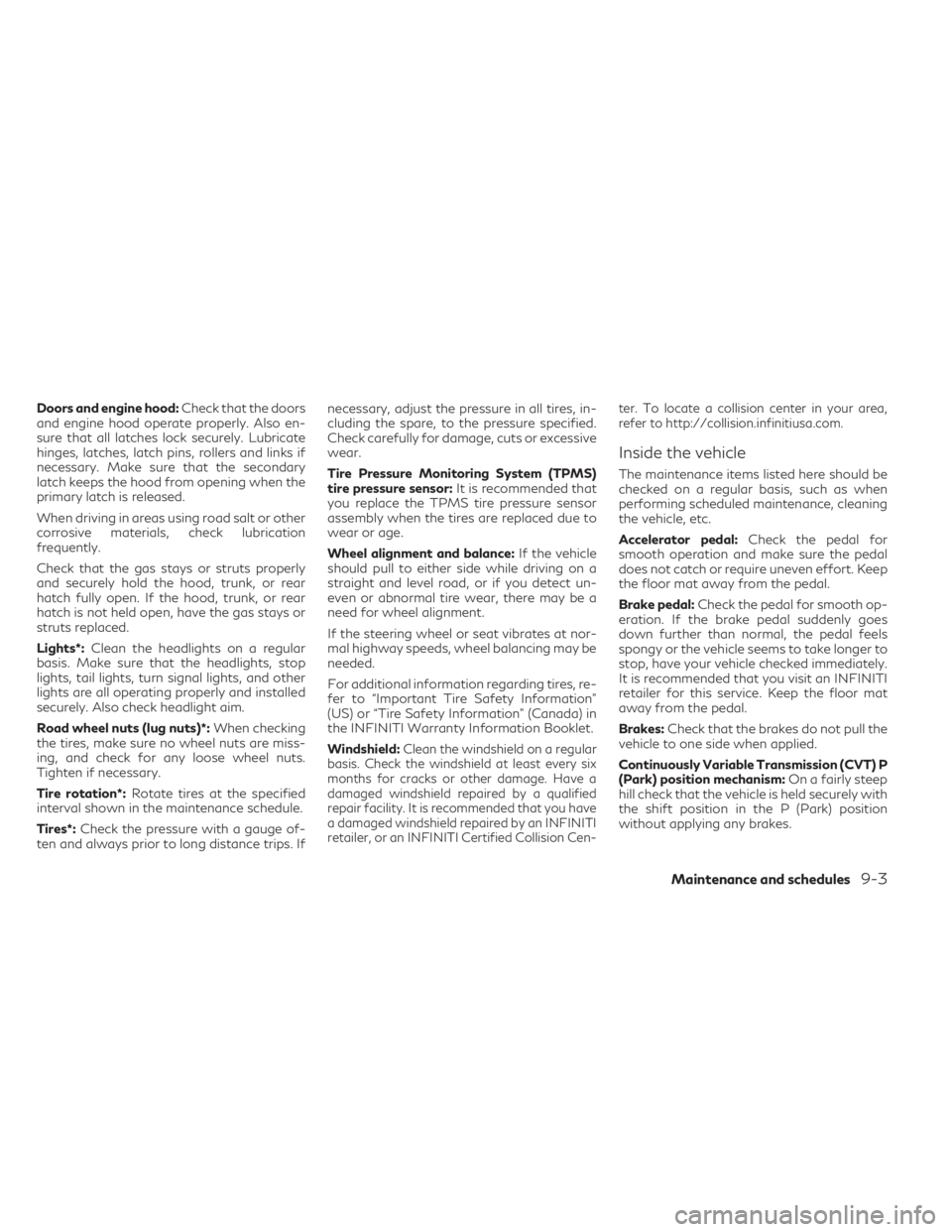steering INFINITI QX55 2023 Owners Manual
[x] Cancel search | Manufacturer: INFINITI, Model Year: 2023, Model line: QX55, Model: INFINITI QX55 2023Pages: 526, PDF Size: 5.75 MB
Page 387 of 526

Normal operation
The Anti-lock Braking System (ABS) operates
at speeds above3-6mph(5-10km/h). The
speed varies according to road conditions.
When the ABS senses that one or more
wheels are close to locking up, the actuator
rapidly applies and releases hydraulic pres-
sure. This action is similar to pumping the
brakes very quickly. You may feel a pulsation
in the brake pedal and hear a noise from
under the hood or feel a vibration from the
actuator when it is operating. This is normal
and indicates that the ABS is operating prop-
erly. However, the pulsation may indicate
that road conditions are hazardous and extra
care is required while driving.
BRAKE ASSIST
When the force applied to the brake pedal
exceeds a certain level, the Brake Assist is
activated generating greater braking force
than a conventional brake booster even with
light pedal force.
WARNING
The Brake Assist is only an aid to assist
braking operation and is not a collision
warning or avoidance device. It is the driv-
er’s responsibility to stay alert, drive safely
and be in control of the vehicle at all times. The VDC system uses various sensors to
monitor driver inputs and vehicle motion. Un-
der certain driving conditions, the VDC sys-
tem helps to perform the following functions:
• Controls brake pressure to reduce wheel
slip on one slipping drive wheel so power is
transferred to a non-slipping drive wheel
on the same axle.
• Controls brake pressure and engine output to reduce drive wheel slip based on vehicle
speed (traction control function).
• Controls brake pressure at individual wheels and engine output to help the driver
maintain control of the vehicle in the fol-
lowing conditions:
Understeer (vehicle tends to not follow the
steered path despite increased steering input)
Oversteer (vehicle tends to spin due to certain
road or driving conditions)
The VDC system can help the driver to main-
tain control of the vehicle, but it cannot pre-
vent loss of vehicle control in all driving
situations.
When the VDC system operates, the
indicator light in the instrument panel flashes
to note the following:
• The road may be slippery or the system may determine some action is required to help
keep the vehicle on the steered path.
VEHICLE DYNAMIC CONTROL (VDC)
SYSTEM
Starting and driving5-141
Page 388 of 526

• You may feel a pulsation in the brake pedaland hear a noise or vibration from under the
hood. This is normal and indicates that the
VDC system is working properly.
• Adjust your speed and driving to the road conditions.
For additional information, see “Slip indicator
light” (P. 2-17) and ”Vehicle Dynamic Control
(VDC) OFF indicator light” (P. 2-17).
If a malfunction occurs in the system, the
andindicator lights come on in the
instrument panel. The VDC system automati-
cally turns off when these indicator lights are
on.
The lower display is used to turn off the VDC
system. When the VDC system is turned off,
the
indicator light, the RAB system
warning light, and the FEB with Pedestrian
Detection system warning light illuminate to
indicate the VDC, FEB with Pedestrian De-
tection, and RAB systems are off.
When the lower display is used to turn off the
system, the VDC system still operates to pre-
vent one drive wheel from slipping by trans-
ferring power to a non-slipping drive wheel.
The
indicator light flashes if this occurs.
All other VDC functions are off and the
indicator light will not flash. The VDC system is automatically reset to on
when the ignition switch is placed in the OFF
position then back to the ON position.
The computer has a built-in diagnostic fea-
ture that tests the system each time you start
the engine and move the vehicle forward or in
reverse at a slow speed. When the self-test
occurs, you may hear a clunk noise and/or
feel a pulsation in the brake pedal. This is
normal and is not an indication of a
malfunction.
WARNING
• The VDC system is designed to help the
driver maintain controllability but does
not prevent accidents due to abrupt
steering operation at high speeds or by
careless or dangerous driving tech-
niques. Reduce vehicle speed and be es-
pecially careful when driving and corner-
ing on slippery surfaces and always drive
carefully. •
Do not modify the vehicle's suspension.
If suspension parts such as shock ab-
sorbers, struts, springs, stabilizer bars,
bushings and wheels are not INFINITI
recommended for your vehicle or are ex-
tremely deteriorated, the VDC system
may not operate properly. This could ad-
versely affect vehicle handling perfor-
mance, and the
indicator light may
flash or both theandindicator
lights may illuminate.
• If brake related parts such as brake pads,
rotors and calipers are not INFINITI rec-
ommended or are extremely deterio-
rated, the VDC system may not operate
properly and both the
and theindicator lights may illuminate.
• If engine control related parts are not
INFINITI recommended or are extremely
deteriorated, both the
andindicator lights may illuminate.
• When driving on extremely inclined sur-
faces such as higher banked corners, the
VDC system may not operate properly
and the
indicator light may flash or
both theandindicator lights
may illuminate. Do not drive on these
types of roads.
5-142Starting and driving
Page 389 of 526

•When driving on an unstable surface
such as a turntable, ferry, elevator or
ramp, the
indicator light may flash
or both theandindicator
lights may illuminate. This is not a mal-
function. Restart the engine after driv-
ing onto a stable surface.
• If wheels or tires other than the INFINITI
recommended ones are used, the VDC
system may not operate properly and
the
indicator light may flash or both
theandindicator lights may
illuminate.
• The VDC system is not a substitute for
winter tires or tire chains on a snow cov-
ered road.
BRAKE FORCE DISTRIBUTION
During braking while driving through turns,
the system optimizes the distribution of force
to each of the four wheels depending on the
radius of the turn.
WARNING
• The VDC system is designed to help the
driver maintain controllability but does
not prevent accidents due to abrupt
steering operation at high speeds or by
careless or dangerous driving tech-
niques. Reduce vehicle speed and be es-
pecially careful when driving and corner-
ing on slippery surfaces and always drive
carefully.
• Do not modify the vehicle’s suspension.
If suspension parts such as shock ab-
sorbers, struts, springs, stabilizer bars,
bushings and wheels are not INFINITI
recommended for your vehicle or are ex-
tremely deteriorated, the VDC system
may not operate properly. This could ad-
versely affect vehicle handling perfor-
mance, and the
indicator light may
flash or both theandindicator
lights may illuminate.
• If brake related parts such as brake pads,
rotors and calipers are not INFINITI rec-
ommended or are extremely deterio-
rated, the VDC system may not operate
properly and both the
and theindicator lights may illuminate. •
If engine control related parts are not
INFINITI recommended or are extremely
deteriorated, both the
andindicator lights may illuminate.
• When driving on extremely inclined sur-
faces such as higher banked corners, the
VDC system may not operate properly
and the
indicator light may flash or
both theandindicator lights
may illuminate. Do not drive on these
types of roads.
• When driving on an unstable surface
such as a turntable, ferry, elevator or
ramp, the
indicator light may flash
or both theandindicator
lights may illuminate. This is not a mal-
function. Restart the engine after driv-
ing onto a stable surface.
• If wheels or tires other than the INFINITI
recommended ones are used, the VDC
system may not operate properly and
the
indicator light may flash or both
theandindicator lights may
illuminate.
• The VDC system is not a substitute for
winter tires or tire chains on a snow cov-
ered road.
Starting and driving5-143
Page 390 of 526

The chassis control is an electric control mod-
ule that includes the following functions:
• Active Trace Control
• Active Engine Brake
• Active Ride Control
ACTIVE TRACE CONTROL
The Active Trace Control senses driving
based on the driver’s steering and
acceleration/braking patterns, and controls
brake pressure at individual wheels to aid
tracing at corners and help smooth vehicle
response.
When the lower display is used to turn off the
VDC system, the Active Trace Control sys-
tem is also turned off.
When the PERSONAL mode is selected, the
Active Trace Control can be set to ON (en-
abled) or OFF (disabled). For additional infor-
mation, see “INFINITI Drive Mode Selector”
(P. 5-29).When the Active Trace Control is operated
and the “Chassis Control” mode is selected in
the vehicle information display, the Active
Trace Control graphics are shown in the ve-
hicle information display. For additional in-
formation, see “Vehicle information display”
(P. 2-19).
If the chassis control warning message ap-
pears in the vehicle information display, it
may indicate that the Active Trace Control is
not functioning properly. Have the system
checked as soon as possible. It is recom-
mended that you visit an INFINITI retailer for
this service.
WARNING
The Active Trace Control may not be effec-
tive depending on the driving condition. Al-
ways drive carefully and attentively.
When the Active Trace Control is operating,
you may feel a pulsation in the brake pedal
and hear a noise. This is normal and indicates
that the Active Trace Control is operating
properly.
You may also feel deceleration when the Ac-
tive Trace Control is operating. However, this
is not a malfunction.
LSD4774
CHASSIS CONTROL
5-144Starting and driving
Page 391 of 526

Even if the Active Trace Control is set to OFF,
some functions will remain on to assist the
driver (for example: avoidance scenes).
ACTIVE ENGINE BRAKE
The Active Engine Brake function adds subtle
deceleration by controlling Continuously
Variable Transmission (CVT) gear ratio, de-
pending on the cornering condition calcu-
lated from the driver's steering input and plu-
ral sensors. This benefit is for easier
traceability and less workload of adjusting
speed with braking at corners.
The Active Engine Brake also adds subtle
deceleration with gear ratio control accord-
ing to driver’s brake pedal operation.
When the PERSONAL mode is selected, the
Active Engine Brake can be set to ON (en-
abled) or OFF (disabled). For additional infor-
mation, see “INFINITI Drive Mode Selector”
(P. 5-29).
When the lower display is used to turn off the
VDC system, the Active Engine Brake system
is also turned off.When the Active Engine Brake is operated at
corners and the “Chassis Control” mode is
selected in the vehicle information display,
the Active Engine Brake graphics are shown
in the vehicle information display. For addi-
tional information, see “Vehicle information
display” (P. 2-19).
If the chassis control warning message ap-
pears in the vehicle information display, it
may indicate that the Active Engine Brake is
not functioning properly. Have the system
checked as soon as possible. It is recom-
mended that you visit an INFINITI retailer for
this service.
WARNING
The Active Engine Brake may not be effec-
tive depending on the driving condition. Al-
ways drive carefully and attentively.
When the Active Engine Brake is operating,
the needle of the tachometer will rise up and
you may hear an engine noise. This is normal
and indicates that the Active Engine Brake is
operating properly.
You may also feel deceleration when the Ac-
tive Engine Brake is operating. However, this
is not a malfunction.
LSD4774
Starting and driving5-145
Page 400 of 526

•Watch for slippery spots (glare ice).
These may appear on an otherwise clear
road in shaded areas. If a patch of ice is
seen ahead, brake before reaching it. Try
not to brake while on the ice, and avoid
any sudden steering maneuvers.
• Do not use the cruise control on slippery
roads.
• Snow can trap dangerous exhaust gases
under your vehicle. Keep snow clear of
the exhaust pipe and from around your
vehicle.
ENGINE BLOCK HEATER (if so
equipped)
Engine block heaters are used to assist with
cold temperature starting.
The engine block heater should be used when
the outside temperature is 20°F (-7°C) or
lower.
WARNING
• Do not use your engine block heater with
an ungrounded electrical system or a
2-pronged adapter. You can be seriously
injured by an electrical shock if you use
an ungrounded connection.
• Disconnect and properly store the engine
block heater cord before starting the en-
gine. Damage to the cord could result in
an electrical shock and can cause serious
injury.
• Use a heavy-duty 3-wire, 3-pronged ex-
tension cord rated for at least 10 A. Plug
the extension cord into a Ground Fault
Interrupt (GFI) protected, grounded
110-VAC outlet. Failure to use the
proper extension cord or a grounded
outlet can result in a fire or electrical
shock and cause serious personal injury. To use the engine block heater:
1. Turn the engine off.
2. Open the hood and unwrap the engine
block heater cord.
3. Plug the engine block heater cord into a grounded 3-wire, 3-pronged extension
cord.
4. Plug the extension cord into a Ground Fault Interrupt (GFI) protected, grounded
110-volt AC (VAC) outlet.
5. The engine block heater must be plugged in for at least2-4hours, depending on
outside temperatures, to properly warm
the engine coolant. Use an appropriate
timer to turn the engine block heater on.
6. Before starting the engine, unplug and properly store the cord to keep it away
from moving parts.
5-154Starting and driving
Page 405 of 526

To shut off the engine in an emergency situ-
ation while driving, perform the following
procedure:
– Rapidly push the push-button ignitionswitch three consecutive times in less than
1.5 seconds, or
– Push and hold the push-button ignition switch for more than 2 seconds.TIRE PRESSURE MONITORING
SYSTEM (TPMS)
This vehicle is equipped with Tire Pressure
Monitoring System (TPMS). It monitors tire
pressure of all tires. When the low tire pres-
sure warning light is lit, and the “Tire Pressure
Low - Add Air” or “Flat Tire-Visit dealer” (if so
equipped) warning appears in the vehicle in-
formation display, one or more of your tires is
significantly under-inflated. The system also
displays pressure of all tires (except the spare
tire) on the vehicle information display screen
by sending a signal from a sensor that is
installed in each wheel. If the vehicle is being
driven with low tire pressure, the TPMS will
activate and warn you of it by the low tire
pressure warning light. This system will acti-
vate only when the vehicle is driven at speeds
above 16 mph (25 km/h). For additional in-
formation, see “Warning lights, indicator
lights and audible reminders” (P. 2-9) and
“Tire Pressure Monitoring System (TPMS)”
(P. 8-27).
WARNING
• Radio waves could adversely affect elec-
tric medical equipment. Those who use a
pacemaker should contact the electric
medical equipment manufacturer for the
possible influences before use. •
If the low tire pressure warning light illu-
minates while driving, avoid sudden
steering maneuvers or abrupt braking,
reduce vehicle speed, pull off the road to
a safe location and stop the vehicle as
soon as possible. Driving with under-
inflated tires may permanently damage
the tires and increase the likelihood of
tire failure. Serious vehicle damage could
occur and may lead to an accident and
could result in serious personal injury.
Check the tire pressure for all four tires.
Adjust the tire pressure to the recom-
mended COLD tire pressure shown on
the Tire and Loading Information label to
turn the low tire pressure warning light
OFF. If the light still illuminates while
driving after adjusting the tire pressure,
a tire may be flat or the TPMS may be
malfunctioning. If you have a flat tire,
replace it with a replacement tire as soon
as possible. If no tires are flat and all tires
are properly inflated, have the vehicle
checked. It is recommended that you
visit an INFINITI retailer for this service.
EMERGENCY ENGINE SHUT OFF FLAT TIRE
In case of emergency6-3
Page 410 of 526

6. After the engine cools down, check thecoolant level in the engine coolant reser-
voir tank with the engine running. Add
coolant to the engine coolant reservoir
tank if necessary. Have your vehicle re-
paired. It is recommended that you visit an
INFINITI retailer for this service. When towing your vehicle, all jurisdictions
and local regulations for towing must be fol-
lowed. Incorrect towing equipment could
damage your vehicle. Towing instructions are
available from an INFINITI retailer. Local ser-
vice operators are generally familiar with the
applicable laws and procedures for towing.
To assure proper towing and to prevent ac-
cidental damage to your vehicle, INFINITI
recommends having a service operator tow
your vehicle. It is advisable to have the service
operator carefully read the following
precautions:
WARNING
• Never ride in a vehicle that is being
towed.
• Never get under your vehicle after it has
been lifted by a tow truck.
CAUTION
• When towing, make sure that the trans-
mission, axles, steering system and pow-
ertrain are in working condition. Use dol-
lies or flatbed if any of the listed systems
are not working.
• Always attach safety chains before
towing. For additional information about towing your
vehicle behind a Recreational Vehicle (RV),
see “Flat towing for all wheel drive vehicle”
(P. 10-20).
NOTE:
If the battery is completely drained, the
transmission will not manually shift to other
positions. For shifting to other positions,
charge the battery or supply power follow-
ing the jump starting procedure. Push the
park button to shift to the P (Park) position
before shifting to other positions.
TOWING RECOMMENDED BY
INFINITI
INFINITI recommends towing your vehicle
based upon the type of drivetrain. For addi-
tional information, refer to the diagrams in
this section to ensure that your vehicle is
properly towed.
TOWING YOUR VEHICLE
6-8In case of emergency
Page 412 of 526

Rocking a stuck vehicle
WARNING
• Stand clear of a stuck vehicle.
• Do not spin your tires at high speed. This
could cause them to explode and result in
serious injury. Parts of your vehicle could
also overheat and be damaged.
If your vehicle is stuck in sand, snow, mud,
etc., use the following procedure:
1. Turn off the Vehicle Dynamic Control (VDC) system.
2. Make sure the area in front and behind the vehicle is clear of obstructions.
3. Turn the steering wheel right and left to clear an area around the front tires.
4. Slowly rock the vehicle forward and backward.
• Shift back and forth between R (Re- verse) and D (Drive).
• Apply the accelerator as little as pos- sible to maintain the rocking motion.
• Release the accelerator pedal before shifting between R (Reverse) and D
(Drive).
• Do not spin the tires above 35 mph (55 km/h). 5. If the vehicle cannot be freed after a few
tries, contact a professional towing ser-
vice to remove the vehicle.
6-10In case of emergency
Page 463 of 526

Doors and engine hood:Check that the doors
and engine hood operate properly. Also en-
sure that all latches lock securely. Lubricate
hinges, latches, latch pins, rollers and links if
necessary. Make sure that the secondary
latch keeps the hood from opening when the
primary latch is released.
When driving in areas using road salt or other
corrosive materials, check lubrication
frequently.
Check that the gas stays or struts properly
and securely hold the hood, trunk, or rear
hatch fully open. If the hood, trunk, or rear
hatch is not held open, have the gas stays or
struts replaced.
Lights*: Clean the headlights on a regular
basis. Make sure that the headlights, stop
lights, tail lights, turn signal lights, and other
lights are all operating properly and installed
securely. Also check headlight aim.
Road wheel nuts (lug nuts)*: When checking
the tires, make sure no wheel nuts are miss-
ing, and check for any loose wheel nuts.
Tighten if necessary.
Tire rotation*: Rotate tires at the specified
interval shown in the maintenance schedule.
Tires*: Check the pressure with a gauge of-
ten and always prior to long distance trips. If necessary, adjust the pressure in all tires, in-
cluding the spare, to the pressure specified.
Check carefully for damage, cuts or excessive
wear.
Tire Pressure Monitoring System (TPMS)
tire pressure sensor:
It is recommended that
you replace the TPMS tire pressure sensor
assembly when the tires are replaced due to
wear or age.
Wheel alignment and balance: If the vehicle
should pull to either side while driving on a
straight and level road, or if you detect un-
even or abnormal tire wear, there may be a
need for wheel alignment.
If the steering wheel or seat vibrates at nor-
mal highway speeds, wheel balancing may be
needed.
For additional information regarding tires, re-
fer to “Important Tire Safety Information”
(US) or “Tire Safety Information” (Canada) in
the INFINITI Warranty Information Booklet.
Windshield:
Clean the windshield on a regular
basis. Check the windshield at least every six
months for cracks or other damage. Have a
damaged windshield repaired by a qualified
repair facility. It is recommended that you have
a damaged windshield repaired by an INFINITI
retailer, or an INFINITI Certified Collision Cen- ter. To locate a collision center in your area,
refer to http://collision.infinitiusa.com.
Inside the vehicle
The maintenance items listed here should be
checked on a regular basis, such as when
performing scheduled maintenance, cleaning
the vehicle, etc.
Accelerator pedal:
Check the pedal for
smooth operation and make sure the pedal
does not catch or require uneven effort. Keep
the floor mat away from the pedal.
Brake pedal: Check the pedal for smooth op-
eration. If the brake pedal suddenly goes
down further than normal, the pedal feels
spongy or the vehicle seems to take longer to
stop, have your vehicle checked immediately.
It is recommended that you visit an INFINITI
retailer for this service. Keep the floor mat
away from the pedal.
Brakes: Check that the brakes do not pull the
vehicle to one side when applied.
Continuously Variable Transmission (CVT) P
(Park) position mechanism: On a fairly steep
hill check that the vehicle is held securely with
the shift position in the P (Park) position
without applying any brakes.
Maintenance and schedules9-3